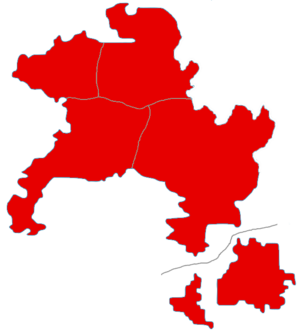Akashian general election, 2010
| |||||||||||||||||||||||||||||||||||||||||||||||||||||||||||||||||||||||||||||||||||||
400 seats in the National Assembly 201 seats needed for a majority | |||||||||||||||||||||||||||||||||||||||||||||||||||||||||||||||||||||||||||||||||||||
|---|---|---|---|---|---|---|---|---|---|---|---|---|---|---|---|---|---|---|---|---|---|---|---|---|---|---|---|---|---|---|---|---|---|---|---|---|---|---|---|---|---|---|---|---|---|---|---|---|---|---|---|---|---|---|---|---|---|---|---|---|---|---|---|---|---|---|---|---|---|---|---|---|---|---|---|---|---|---|---|---|---|---|---|---|---|
| Turnout | 90,2% | ||||||||||||||||||||||||||||||||||||||||||||||||||||||||||||||||||||||||||||||||||||
| |||||||||||||||||||||||||||||||||||||||||||||||||||||||||||||||||||||||||||||||||||||
 Most voted party by province | |||||||||||||||||||||||||||||||||||||||||||||||||||||||||||||||||||||||||||||||||||||
| |||||||||||||||||||||||||||||||||||||||||||||||||||||||||||||||||||||||||||||||||||||
A general election was held in Akashi on 26 June 2010. Kōko Kaga led the Socialist Party to a landslide victory, winning the first single-party majority since 1970. It was the second election nicknamed the "red wave" (Miranian: 赤い波 akai nami) after 1990.
Having been humiliated four years before and facing poor opinion polls, the Socialists elected Kōko leader only a month before the election. This proved to be a masterstroke: Kōko's youth and charisma helped drive a surge in the party's popularity. She enjoyed high-profile support from young voters and the entertainment industry, an overlap dubbed "Scandal voters".
"Kōkomania" caught the centre-right incuments on the wrong foot. The Moderate People's Party's new leader Hiroshi Sone proved less appealing than the retiring Anna Carbone. Liana Ferrari suffered especially badly, forced on the defensive after four years of setting herself up as the next Prime Minister and believing Akashi's electorate now had a "permanent centre-right majority".
While frustrated by the Socialist surge overshadowing her campaign, Communist Party leader Rise Takashima cannily responded to the transformed campaign by urging voters to launch "a new leftist decade". She concentrated her fire on the conservative parties, playing down the Communist–Socialist rivalry.
Results
| General election, 26 June 2010 | |||||||||
|---|---|---|---|---|---|---|---|---|---|

| |||||||||
| Party | Party list | Constituency | Total seats |
+/- | |||||
| PR | % | +/− | STV | % | +/− | ||||
| Socialist Party | 2.953.606 | 39,0% | +31,3% | 3.233.400 | 42,6% | +34,3% | 210 | +178 | |
| Communist Party | 1.120.855 | 14,8% | +2,4% | 888.046 | 11,7% | +0,7% | 50 | +2 | |
| Moderate People's Party | 802.775 | 10,6% | -16,5% | 781.784 | 10,3% | -15,5% | 36 | -86 | |
| Future Party | 643.735 | 8,5% | +2,3% | 622.391 | 8,2% | +0,4% | 27 | +7 | |
| Green Party | 583.148 | 7,7% | +1,2% | 599.621 | 7,9% | -0,1% | 25 | -1 | |
| United Reform Party | 568.001 | 7,5% | -19,4% | 561.670 | 7,4% | -18,0% | 21 | -100 | |
| National Cooperative Party | 492.268 | 6,5% | +0,9% | 508.539 | 6,7% | +0,5% | 20 | -1 | |
| National Union | 136.320 | 1,8% | -0,4% | 151.803 | 2,0% | -0,5% | 5 | ±0 | |
| Conservative National Party | 90.880 | 1,2% | -0,7% | 53.131 | 0,7% | -0,8% | 0 | ±0 | |
| Akashi Renewal Party | 83.307 | 1,1% | -0,7% | 60.721 | 0,8% | -0,8% | 0 | ±0 | |
| Independents | 98.454 | 1,3% | -0,4% | 129.032 | 1,7% | -0,2% | 6 | +1 | |
| Total | 7.573.348 | 100% | — | 7.590.140 | 100% | — | 400 | — | |
| Registered voters and turnout | 8.396.173 | 90,2% | — | 8.396.173 | 90,4% | ||||
| Bloc strength | ||
|---|---|---|
| Bloc | Parties | Seats |
| Crimson bloc | CP, GP | 75 |
| Pale crimson bloc | SP, NU | 215 |
| Light yellow bloc | NCP, FP | 47 |
| Light blue bloc | MPP, URP | 57 |
| Dark blue bloc | CNP, ARP | 0 |
- Government: Socialist Party majority.
The SP surpassed all expectations and won a single-party majority for the first time since 1970. They gained swings of over 30% of the vote and swept all provinces, managing to finish first even in communist-leaning Kobi and conservative-leaning Takao.
Most of the leftist gains came at the expense of the conservatives. The MPP lost 15–16% of the vote and 86 seats, falling to third place for the first time in its existence. The centre-left voters Liana had managed to woo in 2006 deserted the URP, which suffered a greater defeat, losing 18–19% of its vote and 100 seats. Liana had mistaken a temporary victory caused by previous SP turmoil for a permanent realignment.
The smaller parties emerged comparatively unscathed by the left–right competition. The CP gained 2 seats, making it the official opposition. The FP gained 7 seats, a notably good result for leader Yumi Morino amid the excitement of "Kōkomania". The GP and NCP both lost one seat.
Kōko formed a single-party SP government, and took advantage of its majority to quickly pass flagship reforms for its "21st century socialism" program.



